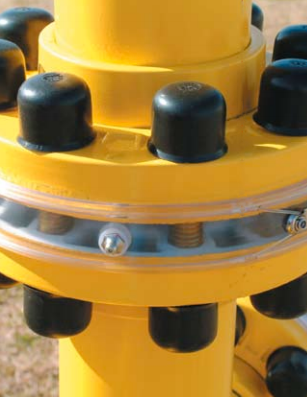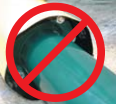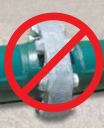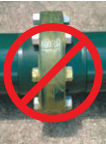Kleerband Flange Protectors by APS

- The quick, easy and effective way to apply protection and prevent corrosion.
-
Description
The new Kleerband Flange Protectors are designed to protect flange face, studs and gaskets on raised face, full face and ring joint flanges from atmospheric corrosion encountered in chemical plants, refineries, gas plants, offshore platforms, onshore oil fields, metering stations, water and wastewater plants, pump stations and underground pipelines.
Controlling corrosion and being aware of its damaging effects is paramount in pipeline maintenance. With the use of Kleerband Flange Protectors and Kleergel Corrosion Inhibitor, flanges remain safe from hazardous and unsightly corrosion that can cause leakage, failure, or even shutdown of equipment. The down time, coupled with the cost of cutting and welding a new flange, replacing flange bolts, nuts and seals, becomes very expensive.
Kleerband Flange Protectors are also designed for use on cathodically isolated flanges to prevent foreign matter from shorting out or bridging over an isolating gasket. All Kleerband Flange Protectors are equipped with an exclusive positive loading relief vent and plug that assures complete loading of flange cavities, and the extruded, clear, flexible polyband allows visual inspection without removal of the protector and ensures complete filling of the flange cavity. In addition, it is non-corroding, providing many years of service life and is totally reusable.
-
Features

Why try and protect flanges the old way when APS has the new, clear advantage to prevent corrosion. With the new Kleerband design, visual inspection of the flange surface can be accomplished without removing the flange protector.

Shrink Sleeves
Shrink sleeve flange shields consist of multiple components (i.e. shrink sleeve, skirting, mastic filler material, masting tape) and require numerous tools for installation (i.e. propane tank, torch, hose, regulator, knife, rags, approved solvent, temperature measuring device, hammer, screwdriver, pliers) along with safety equipment (i.e. gloves, goggles and a fire watch), extra time and personnel to properly install. Due partly to its many installation steps, it is an awkward and complicated method of flange protection. Once installed, flanges cannot be inspected for corrosion without removal of the shrink sleeves and the necessity to repeat the entire installation process. In addition, shrink sleeves are very expensive and must be burned or cut off for removal.

Tapes
Tape products must be wrapped completely around the circumference of the flange. The problem is that not all flanges can be accessed in this manner. Tape covered flanges are not easily filled and usually result in voids in the flange cavity, where condensation forms. Tape products, besides trapping moisture, are non-fillable and not inspectable, making it necessary to cut away and dispose of this non-reusable means of protection.
 Wax Fillers
Wax FillersWax and epoxy fillers are both messy and difficult to apply. These fillers require many tools and are extremely time-consuming. The wax must be melted and poured into a form until it hardens. The epoxy must be injected under high pressure or troweled on the flanges, thus leaving potential voids. Both wax and epoxy fillers, over time, have a tendency to shrink and separate from the flange surface, thus allowing moisture to migrate between the filler and flanges, causing hidden corrosion growth. Once installed, wax and epoxy fillers are noninspectable for corrosion, very messy and difficult to remove and dispose of safely.
-
Specifications
Kleerband Flange Protectors are manufactured of 100% virgin vinyl compound. The polyvinyl chloride resin used to make this compound, as well as the plasticizers and all of the other ingredients, have been granted approval by the FDA in accordance with regulations.
Compound Physical Evaluation
Hardness - Shore A (+ 3)- instantaneous.....................80
-10 second delay...................75Specific Gravity (+ .02) .............................................1.22
Tensile Strength (PSI) ..............................................2425100%
Modulus (PSI)...........................................................1175
Elongation (%)...........................................................435
Low Temperature Brittleness (°F)............................-15
Operating Temperature (°F).....................................Min.-13
Operating Temperature (°F).....................................Max.+167
